Winter’s Arrival on the Milford Track: A Ranger’s Diary
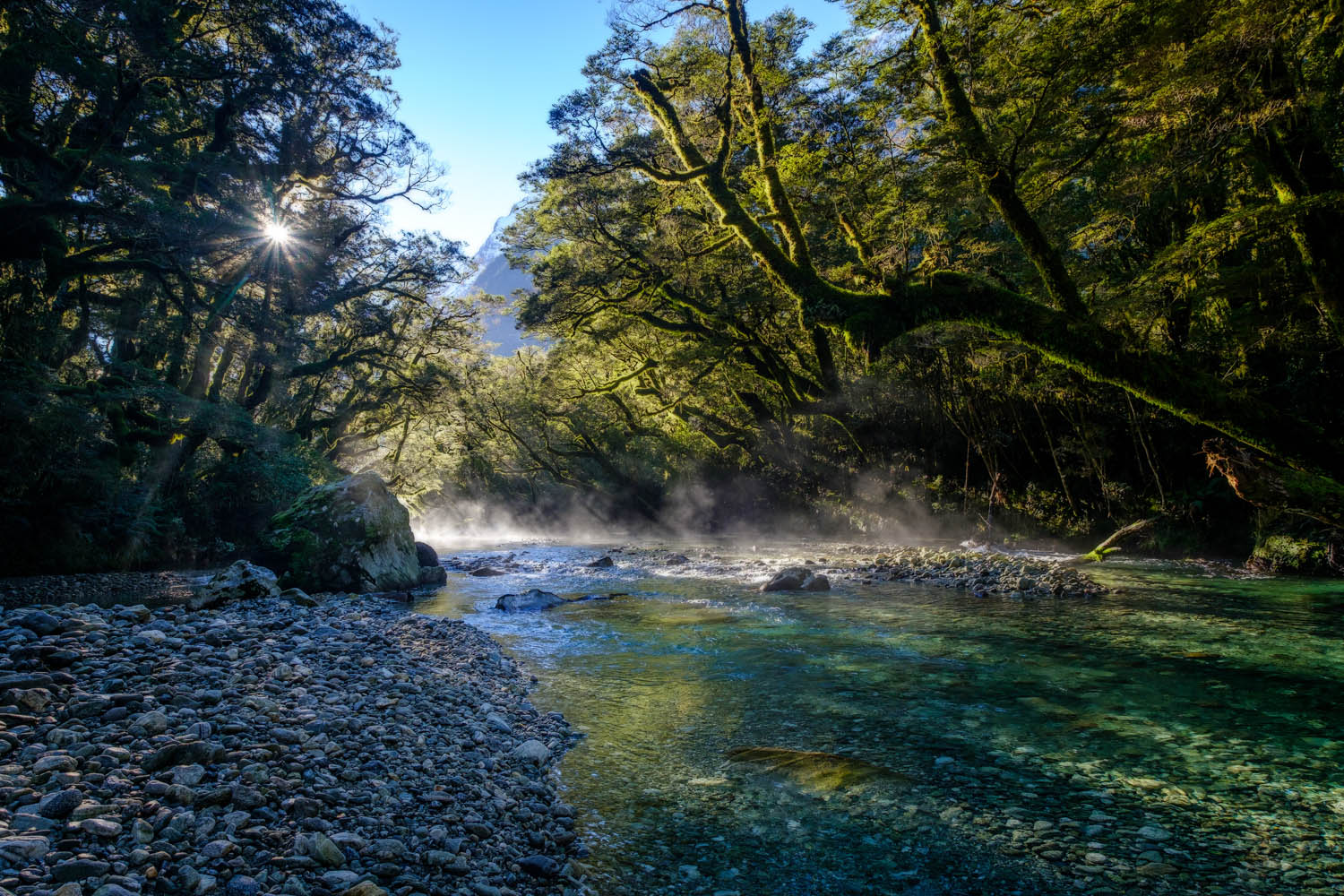
Winter’s Arrival on the Milford Track:
A Ranger’s Diary
New Zealand
Words and photography by Crystal Brindle
It may be one of the most popular walks in the world but what’s it like when winter reclaims the landscape?
The Milford Track is the most famous of all New Zealand’s Great Walks (a selection of trails already considered to be the best and most accessible in the country) and as such packs quite the reputation. It lives up to the fame with towering granite peaks, enchanted forest, and aquamarine rivers. Located in Fiordland National Park, the trail has a system of huts along its length to allow overnight stays.
As a ranger in the park, I had the privilege of living and working along the trail for two weeks to maintain hut facilities and rove the area. The diary that follows is a brief glimpse into my second week where I found myself alone on the trail with only the birds and mountains for company.
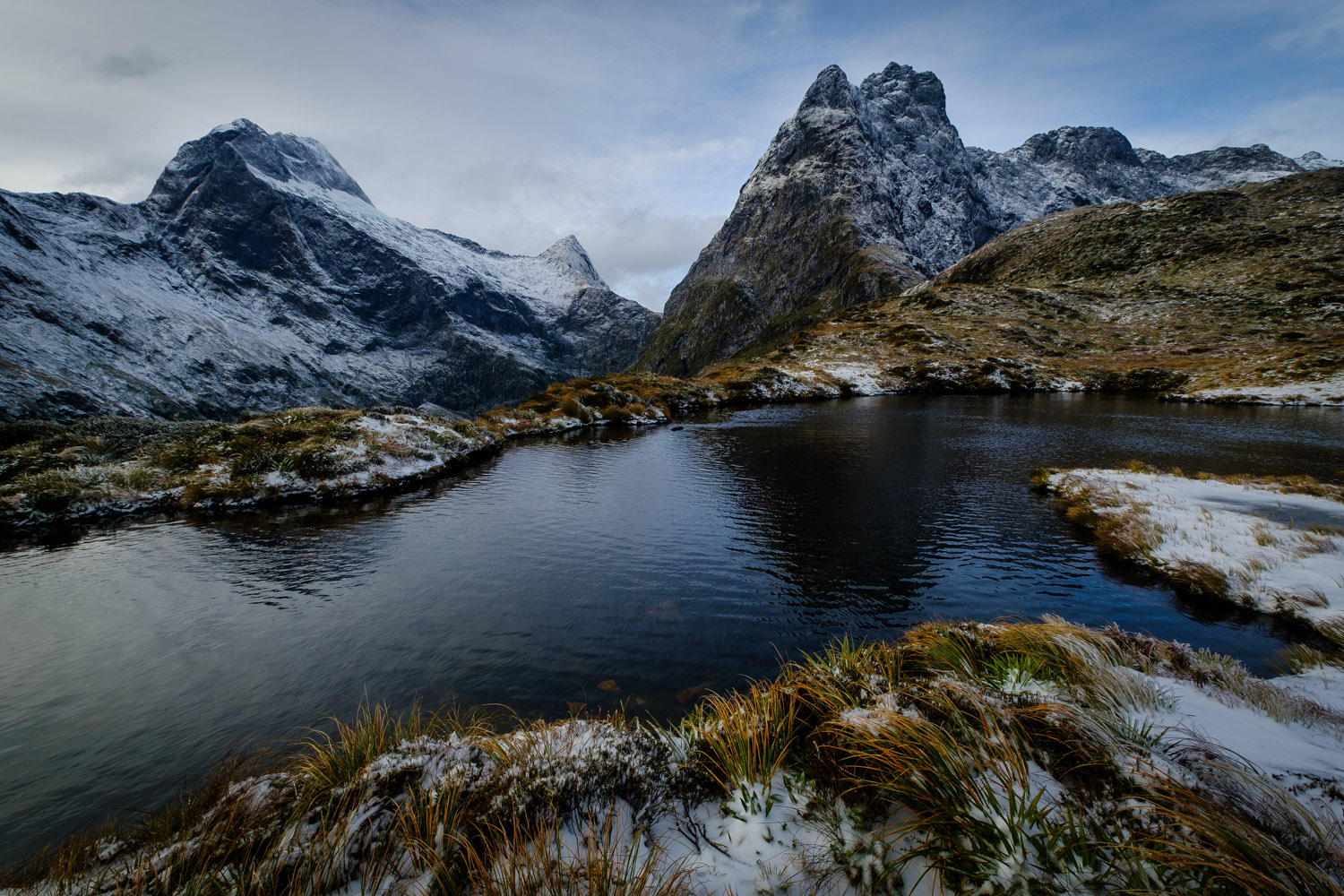
Tuesday the 29th of May: My Perfect Morning Beside the Clinton River
I step out of the trees and onto the riverbank led by the grand snowy mountain-tops that appear and disappear behind a curtain of morning cloud. A pool sheltered behind a large deep grey boulder from the flow of the river shimmers with the light of the reflected white peaks. The water is so clear that there isn’t much difference between the appearance of the river stones below the water or beside the pool except that those below the surface appear slightly magnified and more vibrant. A dark tree reaches out and over the riverbank adding a frame to the scene.
I move closer to the flowing river and step up onto a large rock to get a higher perspective. At this movement a rushing sound catches me off-guard and I look down to discover two whio splashing wings in the water to move away from what had frightened them. I sit down on the rock and they quiet and begin swimming naturally in the water beside me. The instantly-recognizable song of a bellbird filters out clearly from the forest edge behind me as I watch the whio closely. This sound coupled with the gentle rush of the river in otherwise unbroken silence adds intrigue to an already fairy-tale like experience. I am fully attentive and gripped by the beauty surrounding me.
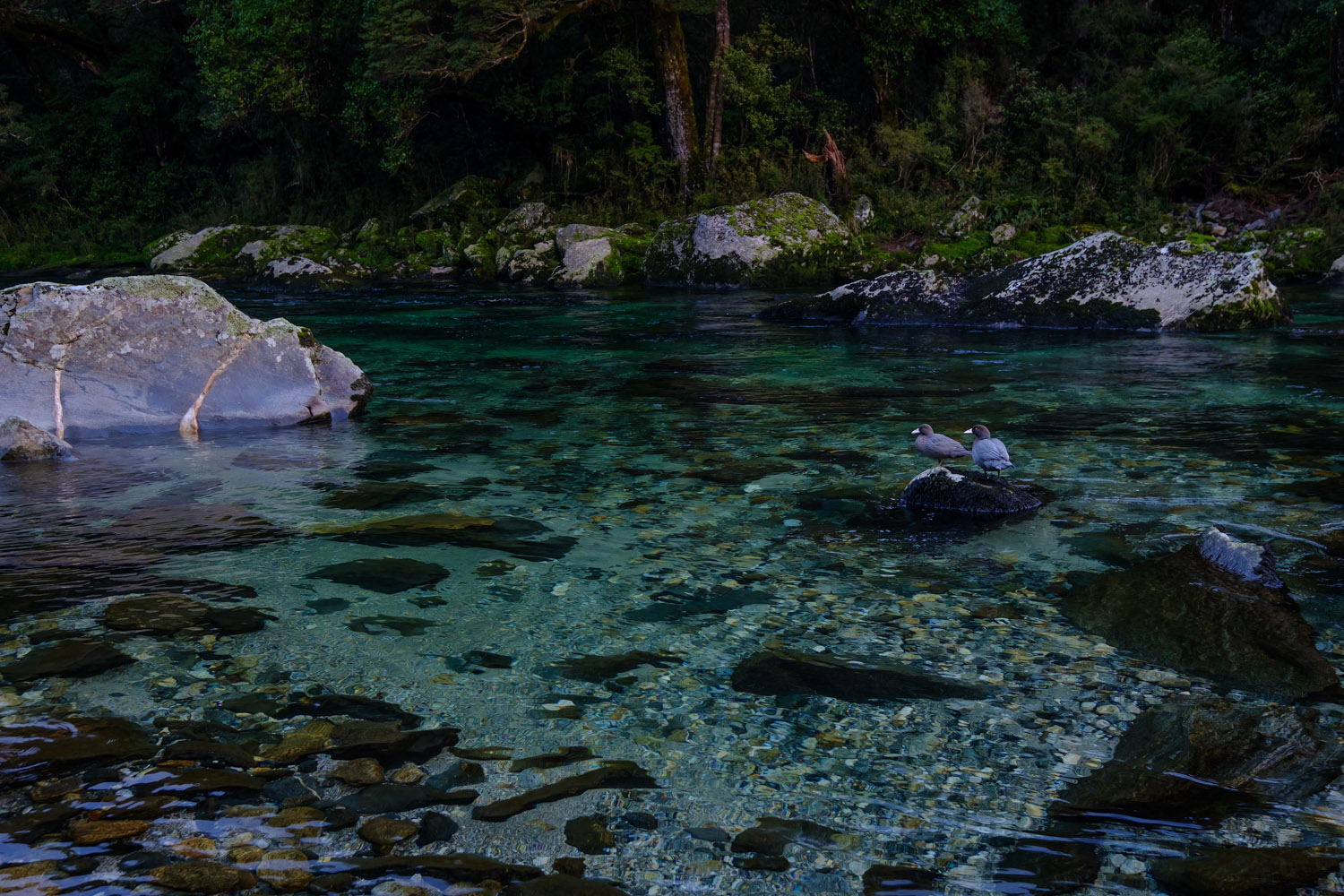
This sound coupled with the gentle rush of the river in otherwise unbroken silence adds intrigue to an already fairy-tale like experience. I am fully attentive and gripped by the beauty surrounding me.
I move along the water’s edge as its surface changes from rippled to smooth like liquid glass funneled through a narrow channel. I notice how the very top of the stream catches light and contrasts with dark hues below. The whio move down-river with me but do so in the middle of the current, riding the water as perfectly designed vessels. Looking above the line of forest on the far bank I study the shapes, textures, and light-play of the high mountains thickly crowned in snow. The unmistakable shape of a karearea cuts the sky across the river and a kaka flies above beech trees that bend toward the water.
All of this in one tiny section of the Clinton River; a cross-section of Fiordland that I’m honored to experience.
Wednesday the 30th of May: The Giving River
This morning I walked to the river first. Before breakfast, before coffee, before even running I strode along the cold, dark path to reach the river. This was out of necessity as the frost on the trees told of freezing everywhere, including the tap on the water tank. So, now, bucket in hand, I reach the river and fill it from a clear pool of icy stillness.
I pause to look at my surroundings and am struck by the realization of all the river gives. Yesterday it gave me peace and wonder, today it gives me water, and through it all it remains the life-blood of the landscape.
I pause to look at my surroundings and am struck by the realization of all the river gives. Yesterday it gave me peace and wonder, today it gives me water, and through it all it remains the life-blood of the landscape. The fish swim in it while the whio feed above and the kaka fly overhead from tree to tree. A great churning force at times that returns to a mirror-like stream of steady calm, the river gives to the land and those that inhabit it in both forms.
Today I appreciate its calm and the water it provides for all that I need. I walk away with a bucket full to the brim of clear, cold water and think that knowing where it comes from more than makes the effort worthwhile.
Thursday the 31st of May: Magic Waters
I have stumbled across the most magical waters on earth. What else can I say? While walking along the track, head down and lost in thought, I happen to glance to my right and notice sunlight on the river upstream as it flows under overhanging moss-covered trees that almost bow to touch it. After a day spent entirely in shady frozen-solid frost hollows, I step off-track to get closer to the light.
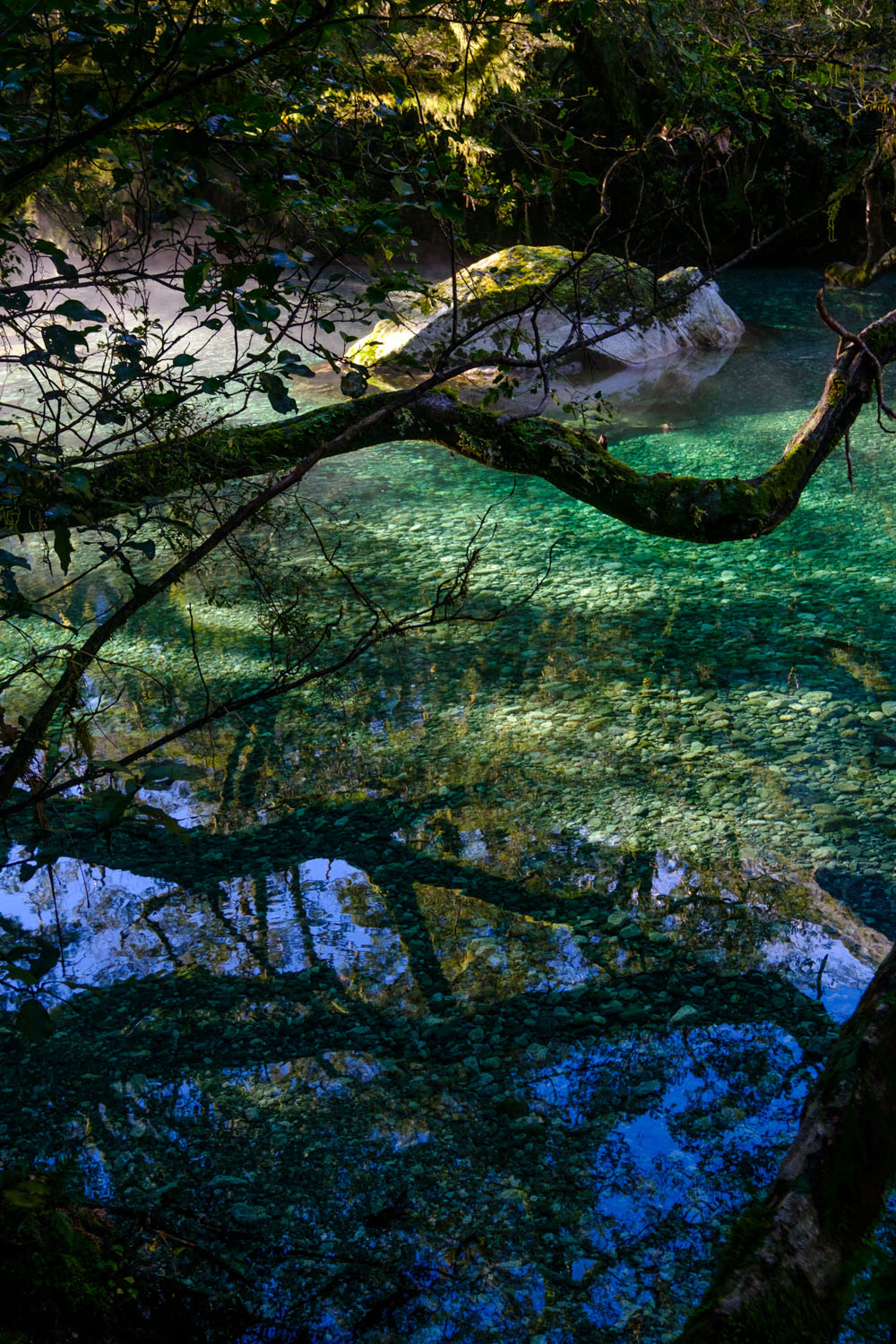
A bend in the channel suddenly allows a view up-stream and the glimpsed light now reveals itself fully as it dances in mist rising off the water. I drop my pack in an instant and scramble down the bank to reach the pebbled shore. It is then that I walk into one of those special spectacles of nature.
Winter daylight might be impossibly short in a valley like this but when it comes it is not to be missed.
Ethereal golden light shines upon the turquoise water of the river, clear to illuminate the very depths of stone where the water is still and shimmering in waves of steam where the river speeds over ridges and rapids. A large boulder is placed so that a clear pool lies behind it as the main flow of the river rushes by.
Large beech trees draped in greenery grow nearly horizontal from either side of the river, framing the snowy heights of the mountains above and overhanging the water and offering reflections below. I walk toward the place in the river where the light is brightest – around the boulder and pool and across the shallow and sparkling water itself to the middle where the flow deepens.

Two trout are visible in the water as clear as if they were on the surface. Magic water in dream-like light as far as I can see in either direction. Winter daylight might be impossibly short in a valley like this but when it comes it is not to be missed.
Friday the 1st of June: Frozen Ground
The first morning of June arrives slowly in this place walled on all sides by impossibly steep granite faces. I notice the sky lightening from behind curtains drawn in a feeble attempt to keep in some heat. I peer out and see the moon bright and full behind the trees and the snow-dusted walls of Mount Balloon coming into focus. Another brilliantly clear day is dawning. I slip down the track on icy compacted snow until I reach the shelter of the forest. A few minutes along brings me to the path leading to a clearing that holds Lake Mintaro.
Dark as earth and completely iced over, the “lake” doesn’t look much like a lake. Even so, the frozen quiet of the space holds me spell-bound. I inch forward over icy ground, water bucket swinging noisily beside me, and reach the edge of a channel of clear, flowing water. The massive snow-covered extent of Mount Hart, whose slippery rock walls form the catchment where the Clinton River begins, looms large from this vantage point. It reflects dazzling white light in contrast with the shadowy world around me and mirrors its form off the still water. Impressive.
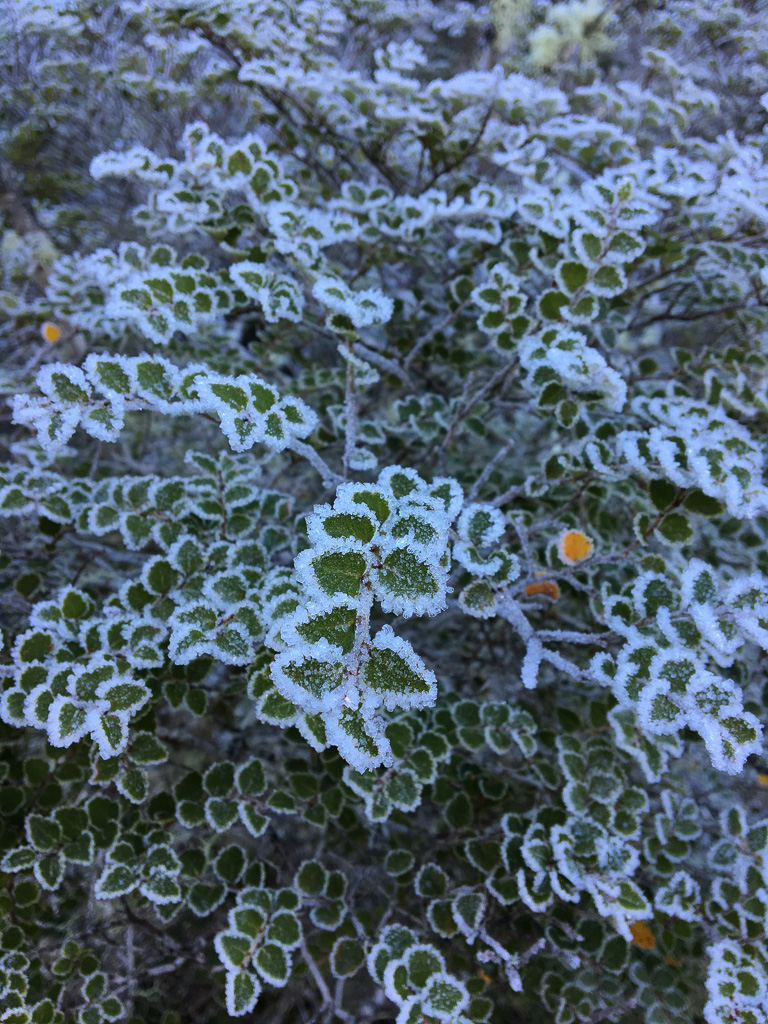 This clearing, a collection of mud flats, sandy soil, frosted plants, and forest edge holds winter’s imprint without letting go. I walk around it everywhere I can, crunching and splintering ice that has collected in depressions of frozen mud. Tracks of birds large and small criss-cross the icy ground.
This clearing, a collection of mud flats, sandy soil, frosted plants, and forest edge holds winter’s imprint without letting go. I walk around it everywhere I can, crunching and splintering ice that has collected in depressions of frozen mud. Tracks of birds large and small criss-cross the icy ground.
At the end of the day the shadow that holds this narrow valley with a relentless grip deepens and frost that never melted begins to add new layers of fine ice crystals.
Noise from the birds begins to sift in and break up the silence: a bellbird from the forest edge, the sharp call of a weka, and the insistent honking of a paradise shelduck on the water. They add to the sound of the breaking ice to create a muted cacophony. Eeking out a living in these mountains is tough, I admire the birds and the special niches they fill.
At the end of the day the shadow that holds this narrow valley with a relentless grip deepens and frost that never melted begins to add new layers of fine ice crystals. The bird song dies away, the occasional boom of cliff band avalanches subsides, and night returns again with an impenetrable frozen silence.
Saturday the 2nd of June: Moonlight over the Mountain
The day begins with moonlight over Mount Hart and Aiguille Rouge and high cloud to give texture and color, a nice change from the entirely clear skies of late. The snowfields and cliffs plastered with ice are etched in clear relief by the rising sun. Clouds sweep over the moon and sometimes dissolve it in their midst.
I start my day early today drawing water from a softly bubbling spring and hauling it back to the hut. I set off mid-morning for a long run down-valley, picking my way carefully over ice-slicked boulders, frozen snow, and frosted ground. The light is brilliant on the colossal mountains of the valley and no wind ruffles their reflection in the many glassy streams I cross.
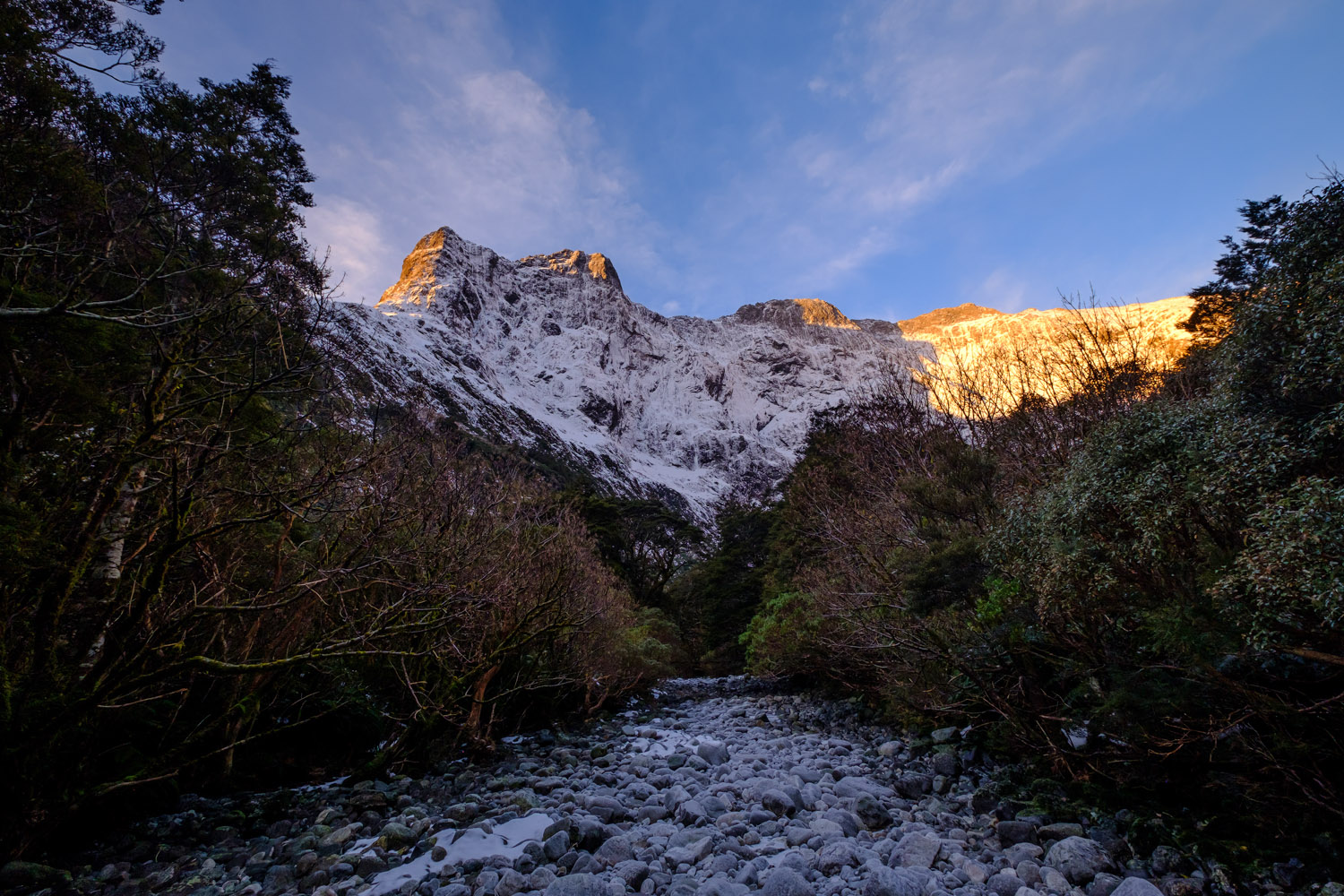
The track opens up as it dashes through clearings and into lower forest allowing me to pick up speed. I make it surprisingly far down valley and then turn on my heels and head back to Mintaro. This time Mackinnon Pass looms large on the horizon and I move steadily closer.
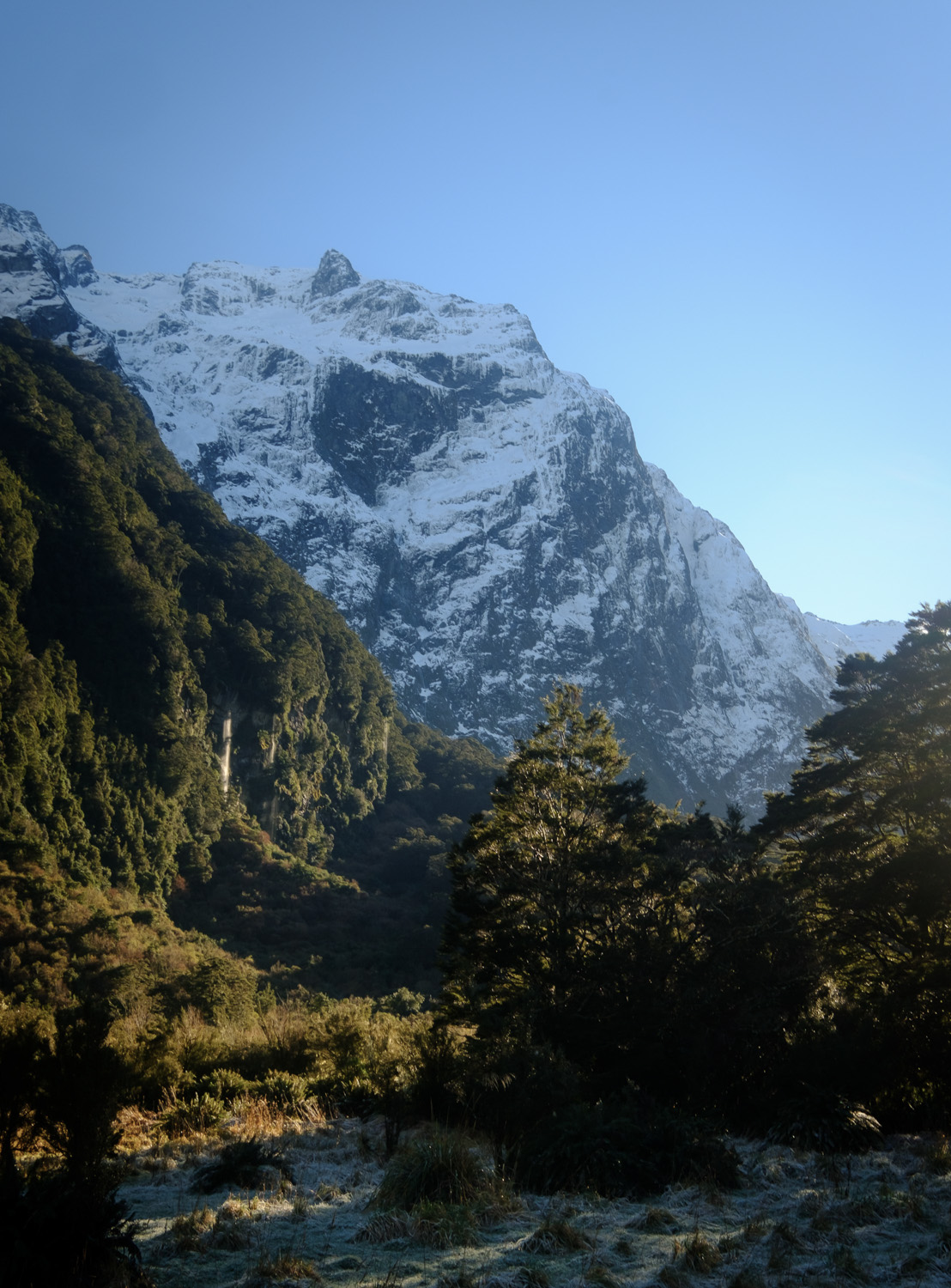
Back at Mintaro, the afternoon and high cloud bring the temperature just above freezing, enough to allow a slight thaw. I enjoy the “Amphitheater of the Avalanche” as I chop wood, pausing to stare upwards as large chunks of snow are dislodged and roll with great noise into the forest. The clearing of Lake Mintaro provides an even better viewing experience with an uninterrupted 360 degree panorama of all mountainsides.
I end the day by setting off just before sunset up the dry riverbed of what will become the Clinton River downstream. The river stones are slick with frost and ice like the finest glass is stretched between them, shattering when I step through. Looking back toward the steep headwall of Mount Balloon I photograph the deep orange and later pink light of sunset from the riverbed. A new vantage point reveals an even greater intensity of scale for the start of this curving valley.
This same mountain wall asserts its presence in fading evening light through the flickering forest as I make my way back. Night pulls in close again under a thin blanket of cloud and the shrill call of a kiwi fills the dark.
Sunday the 3rd of June: The Distance Between Me and My Cup of Tea
As I sit on a frosted fallen log at the edge of the river in the last of the day’s fading golden light I think of the distance that remains between me and my cup of tea. I’ve been dreaming of a cup of lemon ginger tea for many miles now, from my lunch stop in fleeting sunshine (the first I’d felt in three days) through the wide frosty clearings of the Clinton Valley to this place that drew me in beside the water.
This quiet and solitary journey ended when the track drew close beside the river and the lowering sun cast golden beams on the water revealing clouds of mist and whio singing amid the rocks. I hauled off my pack and crept in close beside this friendly pair. The scene I enjoy now is starkly cold but cleanly beautiful. The river here is a rich golden-brown, instead of turquoise, and thus mirrors the evening light. The whio glide so near me that I can almost reach them.
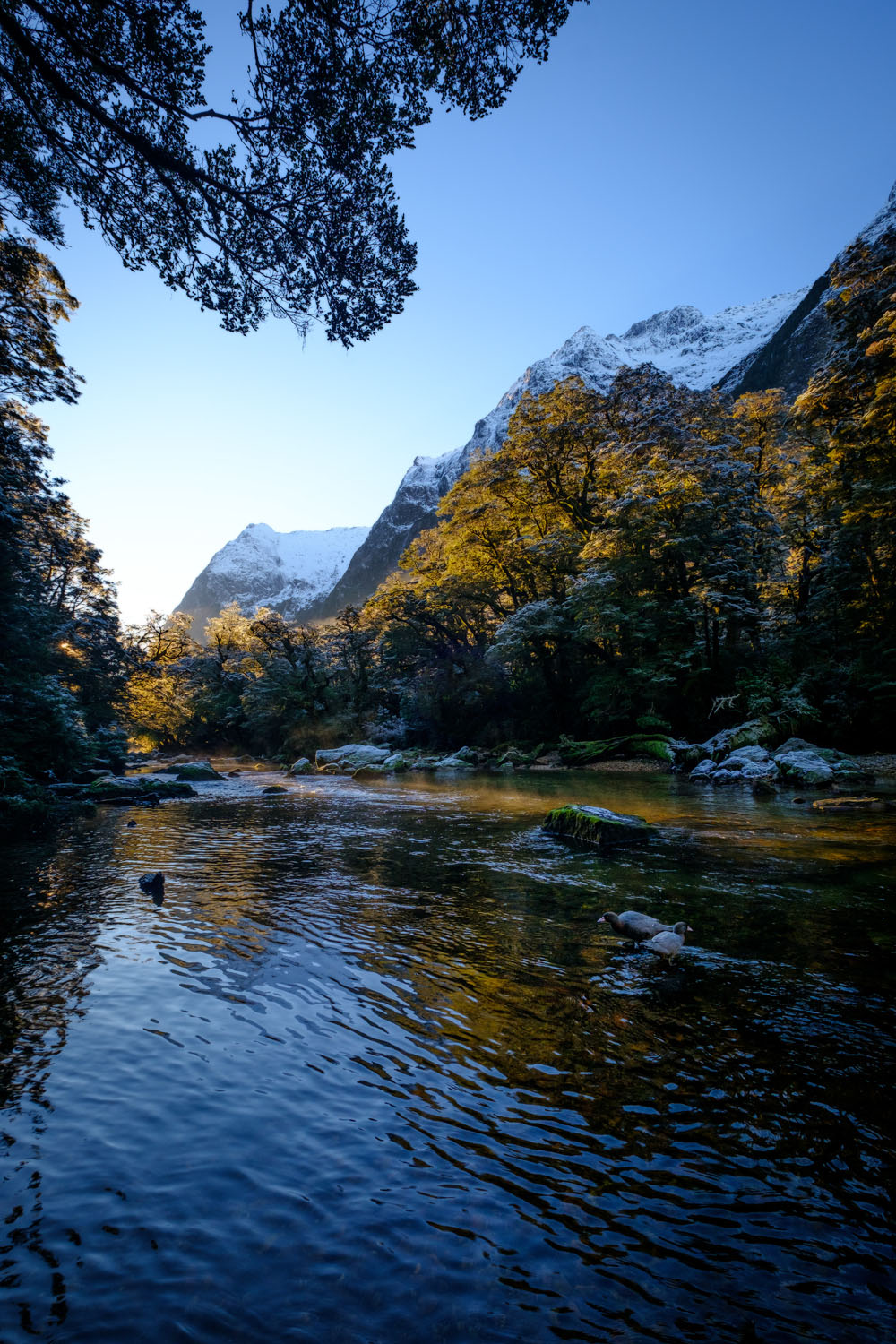
I savor the experience for just another moment and then retreat to the track, heft my bag, and set off.
The scene I enjoy now is starkly cold but cleanly beautiful. The river here is a rich golden-brown, instead of turquoise, and thus mirrors the evening light.
After all, the only way to get closer to that cup of tea is to start taking steps in that direction. Sometimes thinking about all that needs to be done before accomplishing a simple task out here can be overwhelming.
Just three and a half more miles until Clinton Hut, then down to the river and back with buckets of water, next unlock and turn on the LPG outside, start the fire, fill the kettle, light the stove, and finally, tea and warmth. “I’ll get there,” I tell myself.
Sure enough, after a few more bends in the trail and a bit of heavy lifting over frozen ground I start the process of thawing myself and the hut with a roaring fire and a cup of tea. Never has a simple cuppa felt so satisfying.
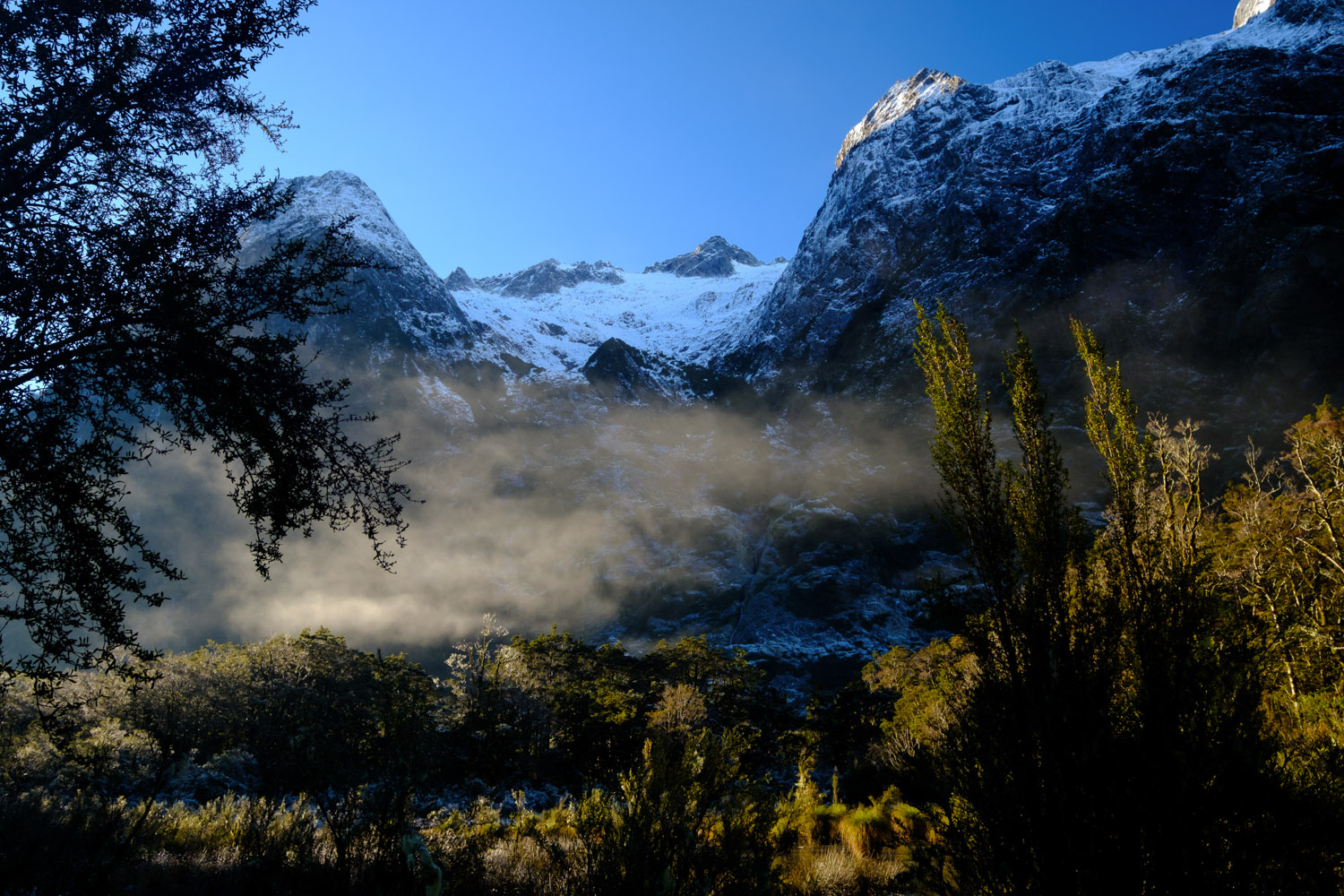
Crystal Brindle is an intrepid explorer and landscape storyteller committed to immersing herself in New Zealand’s greatest landscapes and sharing the wonder she finds in the natural world through the medium of photography. She lives and works in the mountains as a ranger for the Department of Conservation, a landscape photographer, an avid tramper, and a keen trail runner. See more of her work at inpursuitofthewild.com, on Facebook, and Instagram @crystalann_b.
During late august, is there no green or yellow scenery at all? when im googling with ‘milford track’ and ‘august’, I can only see pictures with all snow covered.
That’s right! There’s a bit of green around always as the beech forest (in the east) and the mixed podocarp/broadleaf (in the west) is evergreen but the golden tussock grass gets mostly covered with snow at this time of year. The seasons are flipped and August is mid-winter for us down under! 🙂